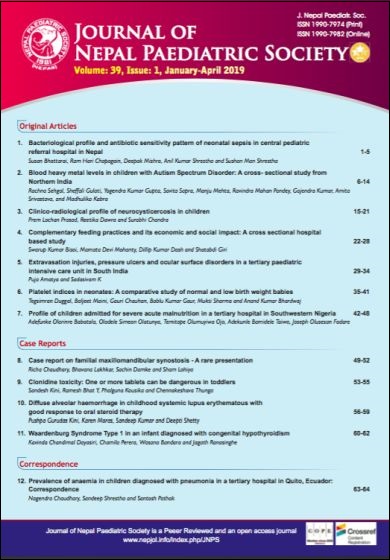Prevalence of Anaemia in Children Diagnosed with Pneumonia in a Tertiary Hospital in Quito, Ecuador: Correspondence
DOI:
https://doi.org/10.3126/jnps.v39i1.22444Keywords:
Anemia, Pneumonia, diagnosisAbstract
Dear editor,
We read with interest the article “Prevalence of Anaemia in Children Diagnosed with Pneumonia in a Tertiary Hospital in Quito, Ecuador” in the recent issue of your esteemed journal and found it very useful and informative1. This article presents the prevalence of anemia in children with pneumonia. However, there are certain points we would like to comment and highlight which might bring more clarity to this issue and will be useful to the readers of JNPS.
- In the abstract (conclusion section), the authors have mentioned that “anaemia or nutritional deficiencies could be a risk factor for respiratory diseases”. The authors seem to draw a conclusion on “nutritional deficiencies” as a risk factor for respiratory disease without any evidence or data provided in the results. We feel that it should better be omitted from the conclusion.
- The authors have mentioned that they used physical findings such as: fever, tachypnea, breathing difficulties, rhonchi, crackles, and wheezing to diagnose pneumonia and them again have mentioned using WHO tachypnea threshold to diagnose pneumonia. It is very unlikely for all the 80 cases to have all the above listed physical findings. Diagnosis of pneumonia in children remains an important yet difficult clinical problem. WHO criteria which uses the presence of cough, fast breathing and chest indrawing to diagnose pneumonia may over-estimate the diagnosis of actual pneumonia2. Chest radiograph remains a diagnostic test of choice in hospitals3. The readers would be keen to know which diagnostic criteria the authors had used to diagnose pneumonia (either clinical or radiological?). If they had used the clinical criteria, what were the exact parameters used to diagnose pneumonia needs further clarification. The authors also need to reply the reason of not including cough and retractions in the inclusion criteria to diagnose pneumonia. The readers would also be keen to know that if any attempt was made to exclude pneumonia like illnesses e.g., bronchiolitis, asthma or cardiac diseases which can mimic pneumonia.
- The authors have mentioned that diagnosis of concomitant conditions that could affect anthropometric or haemoglobin parameters, or that could predispose to pneumonia were excluded. The readers would be interested to know (a) what anthropometric parameters or hemoglobin parameters were excluded and (b) what factors predisposing to pneumonia were excluded which is missing in the material and methods.
- The authors have concluded that anaemia is a frequent condition in paediatric pneumonia and could be a risk factor for respiratory diseases. The study done by the authors was a cross-sectional study which has always a chance of selection bias4. The increased prevalence of anemia in pneumonia patients could have been due to chance, we do not know. Therefore, it is very difficult to answer (in a cross-sectional study) either anemia is prevalent in children with pneumonia or not unless we have some cohort studies on the same. This should have been mentioned as one of the limitations of the study.
- The readers would be interested to know regarding any iron supplements in children aged more than 3 years which might be the cause of decrease prevalence of anemia in this age group.
- In the discussion section, the authors have tried to convince that anemia in the study groups was most likely due to iron deficiency. They have used hemoglobin, MCV and RDW to support the diagnosis of iron deficiency anemia. The sensitivity and specificity of MCV to diagnose IDA is 61.7% and 59.1% respectively with a positive predictive value of 70% 5 whereas using RDW as a criteria to diagnose IDA has a sensitivity of 81% and specificity of 53.4%6.
In the discussion, the authors have emphasized iron deficiency as the cause of anemia in the cases. The authors need to explain that how can they be sure that all the cases of anemia in their study was due to iron deficiency without undergoing iron profile (serum ferritin, % saturation, TIBC).
- It is well known that with subclinical infection, serum iron concentrations are reduced, altering the synthesis of hemoglobin, the main indicator of anemia7. The readers would be interested to know if any attempts were made to exclude those subclinical infections from the enrolled cases with pneumonia.
Downloads
Downloads
Published
How to Cite
Issue
Section
License
Authors who publish with this journal agree to the following terms:
Authors retain copyright and grant the journal right of first publication with the work simultaneously licensed under a Creative Commons Attribution License that allows others to share the work with an acknowledgement of the work's authorship and initial publication in this journal.
Authors are able to enter into separate, additional contractual arrangements for the non-exclusive distribution of the journal's published version of the work (e.g., post it to an institutional repository or publish it in a book), with an acknowledgement of its initial publication in this journal.
Authors are permitted and encouraged to post their work online (e.g., in institutional repositories or on their website) prior to and during the submission process, as it can lead to productive exchanges, as well as earlier and greater citation of published work (See The Effect of Open Access).



